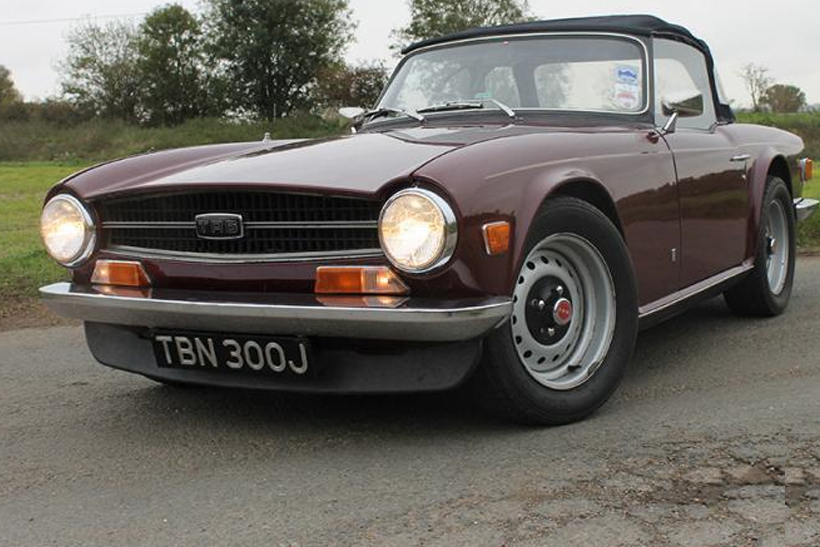The last time I drove a Triumph TR6 on a similarly overcast day back in April. I came away very impressed, finding its blunt, rather unrefined nature and potent performance a refreshing change from the usual ‘slow, but sweet-handling’ ways of your more typical British sports car.
Now I’m back, behind the wheel of another TR6 and it seems that everything is different. This 1971 example is resplendent in a red/purple shade called Damask. It’s a typically ‘Seventies shade that, combined with the contrasting black tail panel and front chin spoiler and the perforated steel wheels, made the TR6 look very dated and unfashionable in the ‘Eighties but is now all part of the charm. As a whole, this is a nice original example and has covered 70,000 miles in its 44 years; the first owner enjoying the car for the first 40 of them. The paintwork looks like it shines up nicely and the cosmetic flaws are few and minorm and the interior has an inevitable patina that produces the irreplaceable smell of a classic car.
This will be the first ‘full fat’ TR6 I’ve driven, as being an early example this one is packing the original 150 horsepower – from 1972 the 2.5-litre six-pot was detuned to 125bhp to improve the tractability and the reliability.
ON THE ROAD
That’s the theory, at any rate. But as I grasp the fat rim of the aftermarket steering wheel and head out onto the road my experience is the exact opposite. My earlier TR6 experience was enjoyable precisely because of the way it drove as if it was a racing car – punchy on full throttle but a bit weak at low speeds, with a curiously rubbery throttle response. I put that down to the nature of the Lucas Petrol Injection. But this car was smooth and responsive at any speed and the effect of pressing the right pedal was instantaneous.
It was so good that the first thing I did when I stopped for photos was to pop the bonnet. Even though I’d read on TRGB’s website that it was still firing on fuel injection, I wanted to be sure that I wasn’t mistaken or that I hadn’t set out in the wrong car! But I hadn’t and, really, even without checking the engine bay the way the engine rumbled into life on the first twist of the key should have given the game away.
Better yet that welcome flexibility hasn’t come at the expense of the engine’s character. It still idles and growls in big off-beat gargles of sound through its twin exhaust pipes. The whole car still throbs suggestively at low revs and the full-throttle acceleration is just as rapid.
As I hunkered down under the hood, which still fits snuggly with no yawning gaps caused by shrinkage or tears,I tried to find out how to turn on the heater (eventually working out it was the toggle with a symbol that looked like a centipede) and set about some of Cambridgeshire’s twistier roads. Once out on the open road, this TR6 kept revealing more differences with its sibling I had driven previously. That one had lacked a certain finesse in the corners, favouring a ‘slow in, fast out’ approach. Whether it was in the steering wheel or the more modern tyres, this one felt altogether sharper, quicker and more accurate in the steering department and much more sure-footed. To mix my animal metaphors, this TR6 gripped like a limpet and changed direction like a housefly. But at heart it still felt like the slightly old-fashioned body-on-frame small car with a big engine that had been such a key part of what had impressed me with the other example.
Another similarity with that car was the ride, which was quite good provided you kept to smooth roads, as the travel was short and the damping gets quite fierce when worked hard. But this one lacked the hint of skittishness that had lurked in my memory of the car I drove in April.
VERDICT
I’ve already counted myself as a big fan of the TR6, but if they can all be as good as this one then my enthusiam for them has now doubled. It’s also an interesting lesson about classic cars as a whole. Once cars get to being 20, 30 or 40 years old each one will have been looked after differently and had different things done to it, often to very different standards. In essence each one becomes unique, so if you don’t like one at the first try then try another. If you did like a car after driving a particular example, keep trying more as they may be even better!
TECH SPEC
ENGINE: 2498cc
POWER: 150bhp
TOP SPEED: 120mph
0-60mph: 8.2secs
ECONOMY: 20mpg
GEARBOX: 4-sp man with o/d







